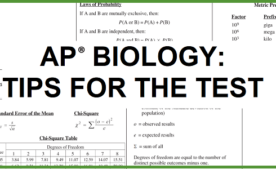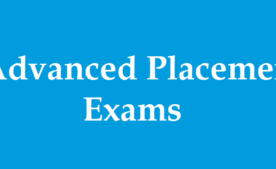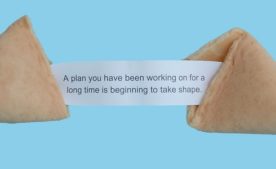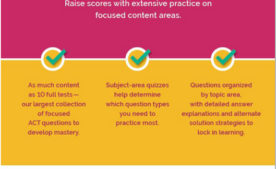If you’re preparing for an AP Biology exam, chances are you’re already enrolled in an AP Biology course. For those who are looking ahead, here’s a little bit about what to expect.
The AP Biology course is meant to be equivalent to an introductory college biology course. There is no prerequisite, so you should feel confident enrolling in the class in whichever year your high school offers it. However, if you are choosing between several AP science courses, you’ll want to consider your college plans and consult your guidance counselor to select the option that will best supplement your college application.
Know The Test Format
As with any standardized test, it’s important to be aware of the format in advance of test day. You should know, for example, that the AP Biology exam includes both a multiple-choice and a free-response section.

Calculators are allowed on both sections of the AP Biology exam, so take advantage of that, both in practice and on test day! Be sure to check that your calculator is on the approved list.
After the multiple-choice section, you will have a 10-minute planning and reading period. Use this time to prepare for the free-response questions (FRQs). The reading period is your opportunity to preview the questions, make sure you understand them, and begin planning, outlining, and even diagramming your answers.
Know What’s Expected
In order to ensure you earn all the credit you deserve for your work; you’ll need to be aware of the rules and expectations of the exam.
Define all key terms you use in your answers to FRQs. Noting this instruction is critical for getting credit! Otherwise “correct” answers will lose points if you do not define the vocabulary terms you used.
Wait until the end of a problem to round. As you’re working through your math computations, be careful not to round prematurely. You don’t want to inadvertently reduce the accuracy of your answer before it’s final.
Follow the instructions strictly. If a question specifically asks you to supply two or three examples, that means the scorer will only consider two or three, and if you provide more, they will score based only on those at the top of the list. They are not going to read through and cherry-pick your best answers, so listing more will only waste time.
Show all your work. For questions that require a calculation, be sure to show your work. Simply giving the correct answer is not sufficient for full credit. The scorers need to see that you knew how to complete the computations, which means that you must even show the work that you put into your calculator! Be aware, though, that this does not mean you cannot leave any evidence of mistakes. Unless you are truly running out of room, just cross out any incorrect work as necessary. Erasing takes longer, and the scorers will disregard anything that is clearly crossed out.
Make sure your responses are clear. Especially since you are required to show your work, it’s important to write legibly and to very clearly highlight your answer! Draw a box around your final answer for each part of a question and label it with its corresponding question identifier (“Part A,” “Part B,” etc.) to be sure there’s no room for confusion. This will also help you to make sure you haven’t missed any components of the question.
Know the Best Practices
Crossing out rather than erasing mistakes is just one way to maximize your time spent working on the test. Your experienced Summit tutor will be able to share other helpful strategies with you. Below are a few of our favorites.
Prioritize based on your strengths. All multiple-choice questions are equally weighted (each is worth 1 raw score point). You won’t get any extra credit for your trouble if you struggle with a particular question, so be sure that you are spending your time wisely to get to the most accessible questions first. Keep in mind that difficulty is relative—if your knowledge of a particular topic is very thorough, it could be that a question that’s meant to be hard is easy for you! Make sure you play to your own strengths. The same goes for the FRQs: You’ll have the chance to skim them during the reading period, so target the ones you feel best about first.
Multiple-choice questions often come in sets referring to the same data or diagram. There is no guarantee that all of the information will be necessary to answer the questions in those sets. Be aware that you may not use every bit of data, and pay close attention to what each question is asking. That will help you identify the important info and filter out what you don’t need.
Always guess aggressively on the multiple-choice section. It’s important to be aware that there is no penalty for wrong answers. For any multiple-choice questions that you don’t feel great about, use process of elimination where possible and always put something down. You won’t lose any credit for getting it wrong, and you might earn the point!
FRQs often have multiple parts that build upon one another. Don’t forget to complete the follow-up steps, but do take them one at a time—letting yourself get overwhelmed by what’s to come will only prevent you from earning points on the early stages! Even if you don’t know how to do the last step, you can still get credit for the first few—and many students find that the previously intimidating last step looks much more approachable by the time they’ve worked through the others. Of course, this does not negate the advice above about playing to your strengths. Don’t let part A prevent you from getting to part B.
Some students find it frustrating that the multi-part FRQs build on one another. It’s important to know that you will not be double-penalized for wrong answers on these questions! It is entirely possible to get part A wrong and still get full credit for parts B, C, and D, even if later parts build on one that you answered incorrectly. In other words, if your answer to a previous step is wrong but you use it correctly for a subsequent step, you will get full credit for the step that was correctly executed. Use this to your advantage: If you’re not sure of the answer to one part of an FRQ, just write something that feels relevant. And consider choosing something you know a lot about—that way, you’ll be on firm ground for the next step.
Know Your Stuff
Finally, it won’t come as a surprise to hear that you need to really know your biology in order to succeed on the AP Biology exam!
Use flashcards. You will have access to the AP Biology Formulas and Equations sheet on the exam, but because consulting it takes time, it’s best to memorize everything you can and use the sheet only when you need to double-check. It’s also important to be aware that the AP Biology test is very vocabulary-intensive, and a glossary is not supplied. We recommend that you create flashcards for any key terms that you don’t have perfectly memorized yet. If you come across unfamiliar terms as you work through practice tests, add them to your flashcard deck! Be sure to learn the Greek and Latin prefixes and suffixes that are commonly used in biology, too. Not only will this help you commit new words to memory, but it will also help if you need to decode an unfamiliar term on test day.
Practice drawing diagrams, maps, or visual abstracts of important biological processes like mitosis or meiosis. Many such processes are very complex and involve multiple steps, cell structures, or molecules. Representing these different pieces by integrating them into visual diagrams can help you to understand how each element of the process contributes to the overall picture. Getting comfortable with diagrams is also great preparation for the multiple-choice questions, which often include sets of 4-5 questions referring to the same data. The ability to interpret and create visual representations of data and biological processes makes up nearly a quarter of the test’s content.
Practice FRQs throughout the year, consistently, whether or not your teacher is assigning them. Getting comfortable with pacing is critical: You should practice completing the two longer questions in 20 minutes each and the four shorter ones in 10 minutes each. You can find practice FRQs to study from online. Keep in mind that questions from more recent tests will be more reflective of the exam you will see, but older questions still cover similar material. When you check your work, be sure to compare it to the sample answers that earned maximum points. This is a great learning opportunity. Look out for useful phrasing and concepts that you can use for future FRQ responses, and for any justification that you might not have thought to include.
Review your lab notebook. The AP Biology curriculum includes 12 major labs. Because the exam places a strong focus on experimentation and on representing and interpreting data, FRQs may require you to design an experiment. Reviewing your lab notebook is a great way to build the necessary foundation for success on these questions. Take note of any experimental or data analysis techniques that you used in each lab. Make sure that you’ve identified the key elements of each experiment: the hypothesis, the statement of independent, dependent, and control variables, the control condition (if applicable), the material list, the procedure, the description of how data will be represented and analyzed, and the conclusion.
Leverage available material. Although the official AP Biology material provided by the College Board is limited, there are several reputable sources for additional material. Khan Academy, Bozeman Science, Crash Course Biology, and the Princeton Review book are all good resources. Look over the list of tested topics from the College Board. If any item on the list gives you that uncomfortable feeling that says it’s not a strong suit, seek out additional material. And, of course, don’t be afraid to ask your teacher or your Summit tutor for further practice—they’ll be delighted to share additional resources.
Taking and performing well in AP courses help students demonstrate their readiness for the rigors of college-level work. Many institutions report that a student’s successful AP experience favorably impacts admission decisions.
Whether you’re looking for ongoing AP subject support throughout the school year or the opportunity to review with an expert and prepare for the AP exam in May, we can help. Contact us about AP tutoring and exam prep.



















